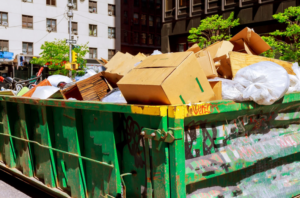
Before your hands meet gloves and boxes start stacking, take a beat. Dive into the core of what needs attention. Not all cleanouts whisper the same tune—some scream urgency with crumbling garages, others hum gently from cluttered attics. Is this a minor purge or a deep reset? A multi-room overhaul or a backyard revival?
Defining your scope early helps the rest fall into rhythm. It’s about laying groundwork not just for labor, but for logic. Start walking your space with fresh eyes. Let the obvious items tug your focus first, but don’t ignore the corners where clutter hides. Mapping out your mess turns chaos into something measurable—and from there, manageable. Clarity is the real first step, long before anything leaves the door.
Build a Timeline That Respects Reality and Rainstorms
Deadlines are tempting—nothing says productivity like a clear, concise plan with dates. However, they often overlook the unpredictable nature of real life. You don’t control the weather, and you can’t predict unexpected roadblocks that will inevitably pop up during a cleanout. Instead of trapping yourself in a fantasy calendar, build your timeline with flexibility and adaptability in mind. Consider not only how much time each task will take, but also how you’ll handle setbacks.
If it rains, will you be able to work indoors, or will you be forced to reschedule? Break down your plan into manageable phases, and remember, pacing is key. Focus on small, achievable goals for each day—clean one room or clear one section of the yard. This allows you to stay on track even when life throws a curveball. Flexibility isn’t a weakness; it’s a strategic advantage.

Identify What Stays and What Says Goodbye
When it comes to sorting through your belongings, it’s more than just separating items into keep or toss piles—it’s a moment of reflection. Each item is part of the story that your space tells, whether it’s the worn-out rocking chair that’s been in the family for decades or the kitchen blender that hasn’t worked since last summer. While some possessions may hold deep sentimental value, others may only be weighing you down.
It’s important to create a decision-making process that respects the emotional connection while allowing you to let go of what no longer serves you. Ask yourself, “Does this item contribute to the space’s future, or is it holding me back?” Donate functional items that still have life in them, recycle what can be reborn, and discard things that have no place in your new chapter.
Gather Supplies That Won’t Let You Down
A successful cleanout starts with the right tools. Without the proper supplies, even the most well-intentioned cleanup effort can quickly spiral into frustration. Think beyond basic trash bags and cardboard boxes—choose heavy-duty options designed to withstand the load. Go for thick, industrial-grade bags that won’t tear under pressure, and sturdy boxes that won’t collapse halfway through the process.
Also, consider gloves that protect your hands from sharp objects and dusty corners, safety goggles to shield your eyes from debris, and permanent markers for clear labeling. Having the right gear will not only help you avoid injury but will also keep your momentum strong. Cheap materials often lead to unnecessary delays and irritation, so invest in quality supplies. And don’t forget about the essentials for staying energized during the task: plenty of water, snacks, and a good playlist to keep spirits high.
Break It Down by Zones Not Emotions
A successful property cleanout requires clear structure, and that means focusing on zones rather than allowing emotional attachments to take over. When you approach your space by zones—kitchen, garage, attic, and so on—you create a system that’s both efficient and manageable. Avoid the temptation to get sidetracked by sentimental clutter tied to specific rooms. Instead, break your cleanout into logical segments, and stick to one zone at a time.
This minimizes overwhelm and prevents burnout. If a zone feels too big, shrink it further. Start with a single shelf, a corner, or a drawer, and gradually expand from there. Completing one zone gives you a sense of accomplishment and momentum, making it easier to push forward to the next. Working zone by zone helps maintain focus and ensures you don’t spread yourself too thin.
Prepare for Disposal Before the Pile Grows Tall
The most common mistake people make during a cleanout is leaving disposal planning until the very end. By then, your pile of junk has grown to overwhelming proportions, and deciding how to move it can feel like an additional burden. Instead, make disposal part of your strategy from the start. Before you begin sorting through your belongings, decide where each type of waste will go. Have a plan for donations, recycling, and trash.
Whether it’s renting a dumpster for larger debris or arranging for a pickup service, having a plan in place will save you time and energy when the clutter starts to pile up. Don’t forget about logistical concerns, like driveway access, parking, and municipal rules about bulk waste disposal. Organizing the removal process in tandem with sorting will keep things moving efficiently and prevent bottlenecks. The goal is to avoid the dreaded “junk pile” that becomes a roadblock.
Consider Donations, Recycling, and Second Chances
A cleanout isn’t just about getting rid of things; it’s also an opportunity to give your belongings a second life. Many items that are no longer useful to you may still be valuable to someone else. Instead of tossing perfectly good goods into the landfill, consider donating functional items to local charities or thrift stores. Clothes, furniture, and electronics can all find a new home and serve a new purpose.
Recycling is another excellent option for items that are no longer usable but can be repurposed or broken down into new materials. By recycling, you contribute to sustainability while keeping your cleanout environmentally responsible. As you go through each item, ask yourself if it could be passed forward to someone else who might need it. When you give away what you no longer need, you’re not just decluttering—you’re contributing to your community and the planet.
Don’t Forget the Paperwork and the Hidden Details
When it comes to cleaning out a space, it’s easy to focus on the big, bulky items—the furniture, the boxes, the appliances—but the hidden clutter often gets overlooked. One area that tends to slip through the cracks is paperwork. Old tax returns, expired warranties, medical records, and bills can accumulate over the years and become just as much of a burden as physical clutter. Sorting through paperwork requires a careful approach.
Share anything that contains sensitive personal information, such as bank statements or old tax records, to protect your privacy. Keep important documents organized in clearly labeled folders, and consider scanning important papers into digital files for future reference. Don’t forget about hidden spots where paperwork may be stashed, like filing cabinets, drawers, or even old briefcases and boxes. By addressing your paperwork during a cleanout, you ensure that you’re fully organizing your space and safeguarding your personal information at the same time.
Know When to Call in Professional Backup
Sometimes, no matter how prepared you are, a cleanout can become too much to handle on your own. Whether it’s the sheer volume of items, oversized furniture, or hazardous materials like old paint or chemicals, there are moments when it makes sense to call in professionals. Professional junk removal services specialize in heavy lifting, proper disposal, and sorting through items that may be difficult or dangerous to handle without proper training.
When you hire experts, you’re saving yourself time, physical strain, and potential injury. They’ll show up with the right equipment, work quickly, and handle the logistics of disposal. Additionally, professionals are skilled at dealing with items that need special attention, like electronics, old furniture, or materials that require special recycling. Calling in help doesn’t mean you’re giving up—it means you’re making a smart move to ensure the job gets done right.
Touches and Resetting the Space for a New Chapter
After the dust settles and your space is cleared of clutter, it’s time to reset and give your newly organized area its best potential. This is when the transformation truly begins. A cleared space is a blank canvas, ready to be shaped into something new and functional. Take time to consider what you want the room to serve. Do you need a home office, a guest room, or simply more open space? The possibilities are endless.
Walk through the area with fresh eyes and ask yourself how you can make the most of the newfound space. Whether it’s rearranging furniture, adding a fresh coat of paint, or updating fixtures, small touches can go a long way in bringing your vision to life. Don’t forget about the basics: cleaning the floors, fixing minor repairs, and adding simple decor items that elevate the space. The act of resetting is about more than just cleaning—it’s about creating a space that reflects your needs, preferences, and aspirations.
Conclusion
Planning a full property cleanout is more than just rolling up your sleeves—it’s a mental, emotional, and physical process that requires serious preparation. Whether you’re clearing out a loved one’s estate, downsizing your home, or prepping a property for sale or renovation, having a clear plan and realistic timeline is key. It’s not just about removing stuff; it’s about creating space for what’s next. And sometimes, that means calling in the pros to help lighten the load.
When you’re ready to clear the clutter and start fresh, 606 Junk Removal and Dumpster Rental in Chicago, IL is here to help. Their team handles the heavy lifting, sorting, and hauling so you can focus on what matters most. Call 773-412-4902 or email info@606junk.com today to schedule your full property cleanout and take the first step toward a cleaner, clearer tomorrow.
